“When I studied architecture at ETH Zurich, my professor, Peter Märkli, took us on a trip to Paris,” recalls 59-year-old Roger Boltshauser, founder of Zurich-based Boltshauser Architekten, of his days at Switzerland’s Federal Institute of Technology. “The first thing we saw was the Maison de Verre.” Pierre Chareau and Bernard Bijvoet’s 1932 magnum opus would leave a profound mark on the impressionable student, sparking a lifelong passion for glass blocks. Boltshauser’s other obsession is rammed earth, a material he has used on numerous occasions and whose low-carbon potential he pushed to the limits at Haus Rauch (Schlins, Austria, 2008), a family home largely built from soil excavated on-site. Although it might not seem so at first, these two interests intersect at this ETH Zurich research building, whose sleek, high-tech appearance belies its passive approach.
Shared by the departments of health science, IT, and electrical engineering, the $220 million Gloriarank Laboratory Center (GLC) sits about a quarter mile uphill from ETH Zurich’s Gottfried Semper–designed main building, next door to Zurich University’s campus. For ETH Zurich, which wanted to develop research partnerships with its sister institution, the location was so strategic that it was prepared to demolish a 1920s building to squeeze the GLC into a site that was too small for it; because of a four-story height limit (imposed by the wealthy villa owners on the hillside above), the only way to accommodate the 243,000-square-foot program was by digging deep. “Given these conditions, we wondered whether we should even enter the design competition, says Boltshauser. “If we did, we had to make something smart out of it.”
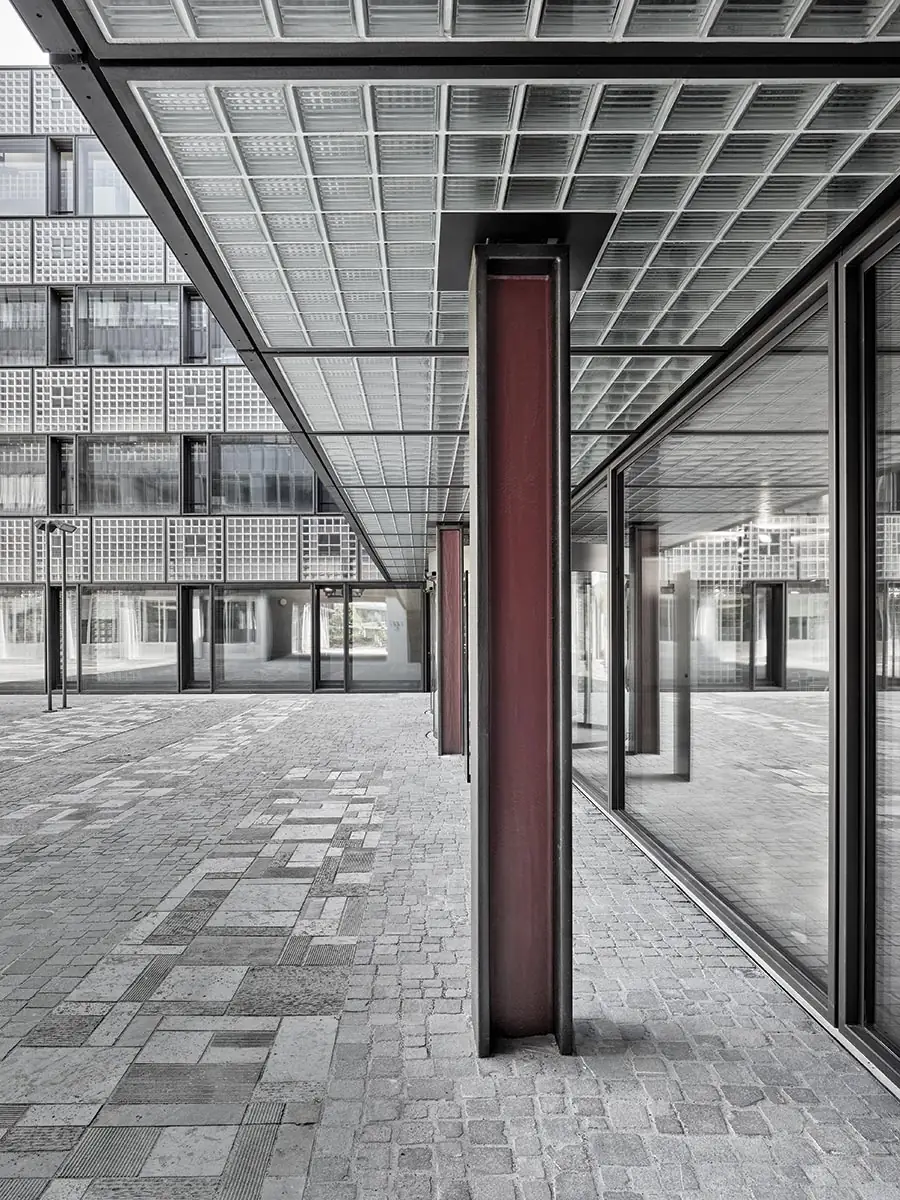
A monumental stair (top of page) leads up to the courtyard (above). With its red-and-black columns, the new building freely quotes the Maison de Verre. Photo © Kuster Frey, click to enlarge.
For the 2010 contest, the firm proposed a C-plan building that links up with a 1970s ETH Zurich block to form a courtyard, at the center of which stands a landmarked 1950s lecture hall, which Boltshauser would end up restoring as part of the GLC scheme. The architects located the labs, which produce a lot of heat, in the basement and along the cool northeastern facade, and lined up professors’ offices to the southeast, overlooking Lake Zurich. Creating space for the required square footage meant not only digging down but also removing part of the hillside, so Boltshauser decided that the enormous concrete retaining wall—which represents a vast amount of embodied carbon—should work a little harder by incorporating ventilation ducts. Thanks to the hill’s inert mass, the outside air brought through the ducts would, he calculated, be cooled in summer and warmed in winter, and could then be pumped into the cavity of his double-skin all-glass envelope to help maintain stable indoor temperatures. With its abundant glass blocks, Boltshauser’s proposed envelope paid tribute not only to the Maison de Verre but also to ETH Zurich’s nearby Maschinenlaboratorium, a 1930s building that he greatly admires.
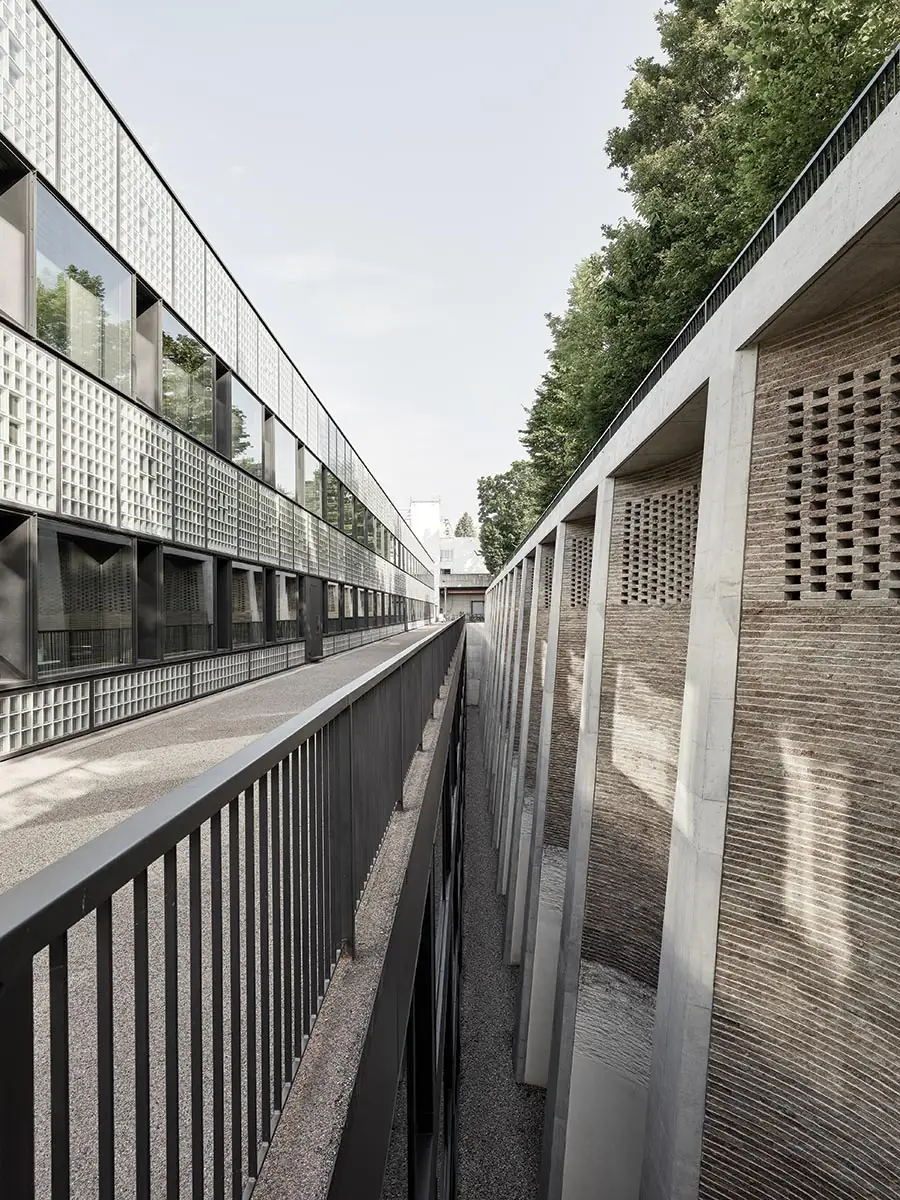
1
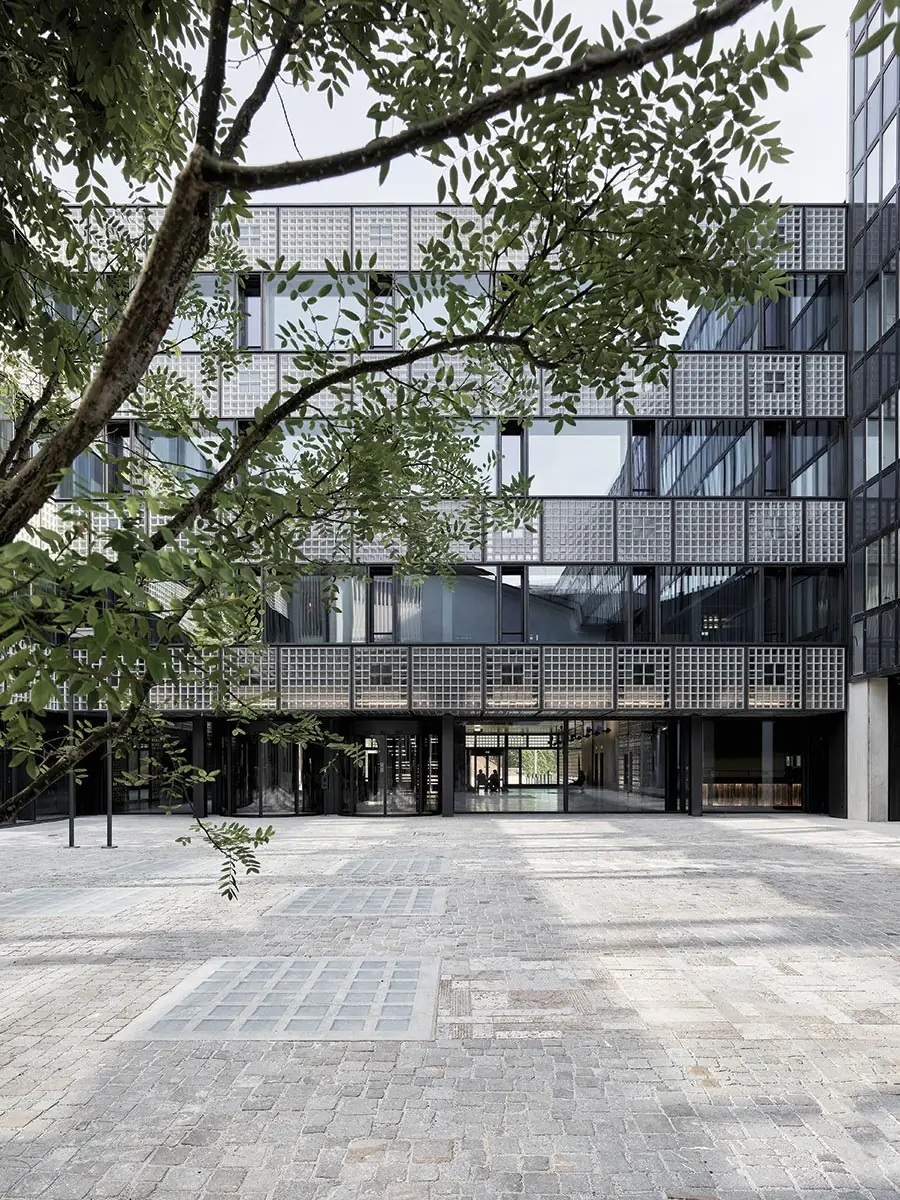
2
Nestled into a hillside, thanks to a giant retaining wall (1), the GLC features ingenious HVAC and ventilated glass block facades (2). Photos © Kuster Frey
Seduced by the concept, ETH Zurich awarded Boltshauser Architekten first prize—ahead of David Chipperfield and Caruso St. John—on the condition that they prove their air-circulation concept would actually work. On the advice of engineers, the architects dropped the idea of pumping the retaining-wall air into the envelope, instead using it to ventilate the building’s interior, and turned to natural forces to regulate the facade temperatures: in summer, the envelope cavity draws up cooling air like a chimney through external openings at its base, while in winter electrically operated flaps close it off, floor by floor, so that it becomes a heat trap (the flaps also shut in the event of fire). “It may seem paradoxical, with all that concrete, but if we hadn’t done Haus Rauch, we couldn’t have designed the GLC,” says Boltshauser, who hopes the building will achieve energy savings of at least 25 percent.
“Our work isn’t just a question of carbon reduction—it’s always about architecture too,” he continues. “Jean Nouvel, Chareau, and of course Le Corbusier—this was my school,” and the influence of all three is palpable in the beautifully handled facades, which recall both Nouvel’s Institut du Monde Arabe and Corbu’s Immeuble Molitor. “We wanted to treat these elevations like a palazzo,” he continues, referring to the combination of narrow operable windows and square fixed panels decorated with larger glass blocks at their center, which together act like phantom pilasters, bringing a sense of verticality to an otherwise very horizontal composition.
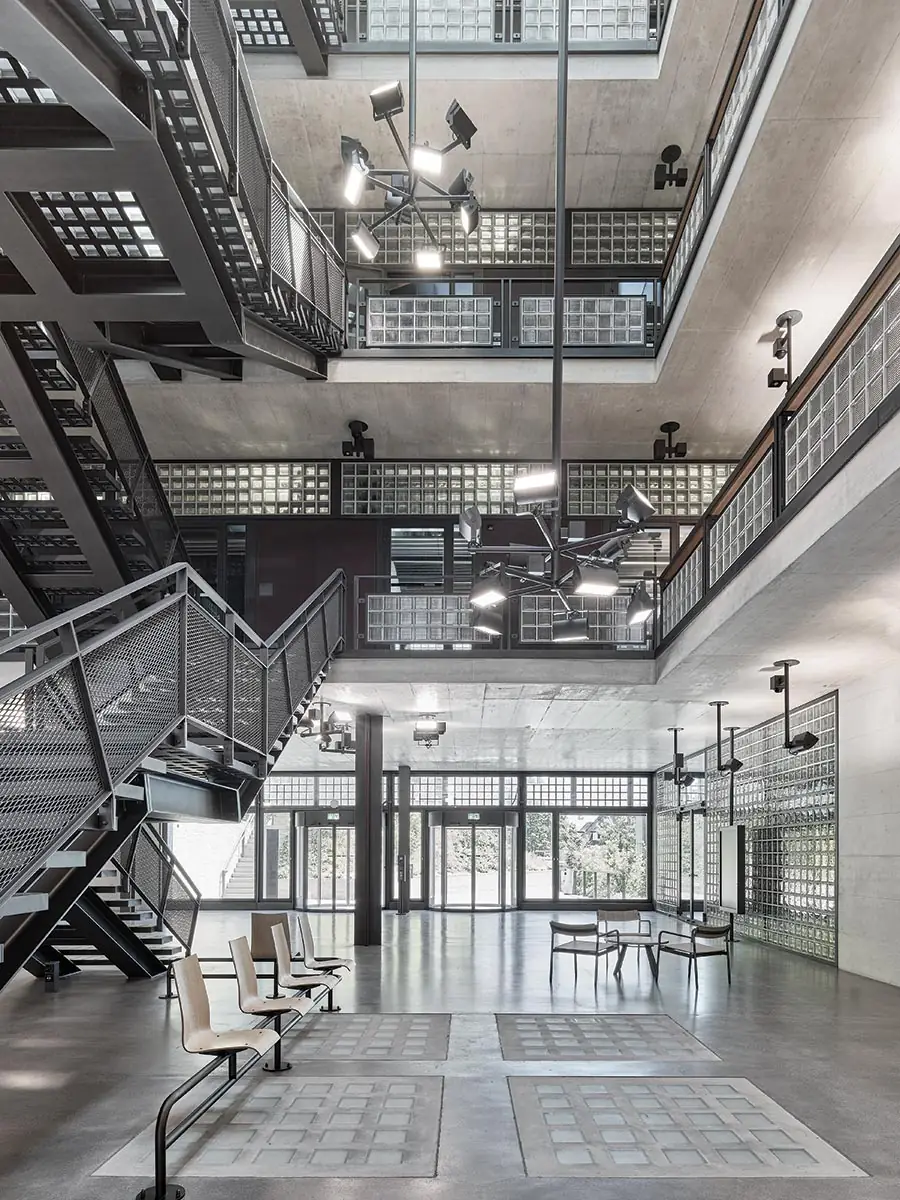
The entry leads to a daylit atrium. Photo © Kuster Frey
Inside, a spacious entrance hall leads to an airy top-lit atrium, at whose center rises a bravura stair in steel and glass block. As well as reflecting Boltshauser’s aesthetic obsessions, the atrium responds to the client’s request that the different research teams be encouraged to mix and meet. To provide stability for sensitive lab equipment, the GLC’s basic structure comprises steel columns and concrete floor slabs, with concrete stair cores for wind bracing. “Foreign architects always tell us how crazy Swiss regulations are,” laughs Boltshauser. “‘All these layers you’re forced to add,’ they say. Here, we tried to strip away as much as possible.” As a result, everything is exposed for what it is, with ceilings and core walls proudly bearing their board marks, floors in honed concrete, and columns that are painted red and black like those at the Maison de Verre. Hardly a sack of plaster entered the building site, since the architects used either glass block or sandwich partitions faced in perforated metal (another nod to Chareau) to divide up the interior.
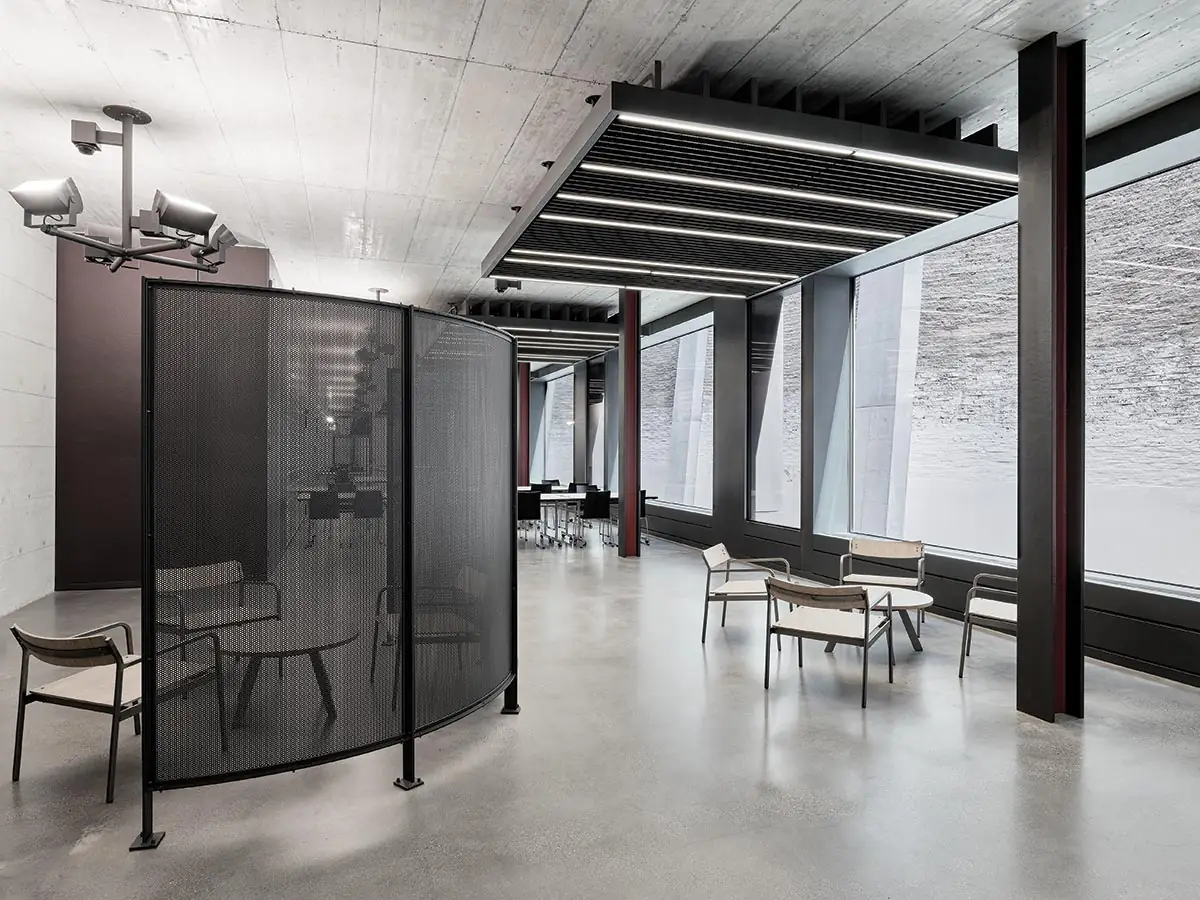
3
Inside, the architects left concrete ceilings, core walls, and floors exposed (3 & 4). Photos © Kuster Frey
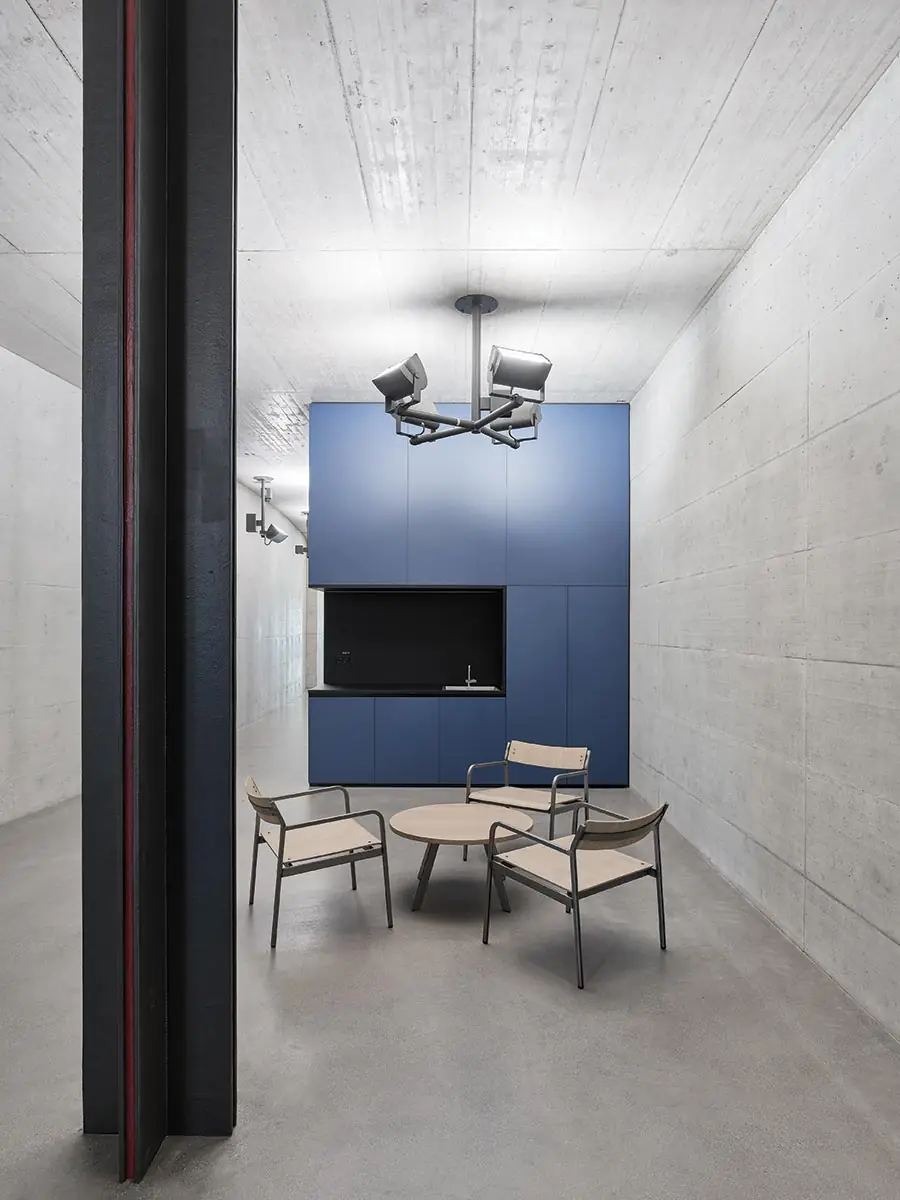
4
“A laboratory is a machine, and we wanted the architecture to reflect that,” says Boltshauser. “But if you’re too ‘chatty,’ it’s not so interesting.” After the classical calm of the courtyard, and the equally quiet entrance hall, HVAC and plumbing begin to be revealed as you progress through the building, with full exposure on the lab ceilings. Indeed, Boltshauser Architekten obsessively designed every square inch of the GLC, from the restaurant furniture to the Chareau- and Le Corbusier-inspired lighting, which integrates smoke and movement detectors to free up the ceiling. A classic total-design Gesamtkunstwerk, this was a true labor(atory) of love.
Click drawings to enlarge
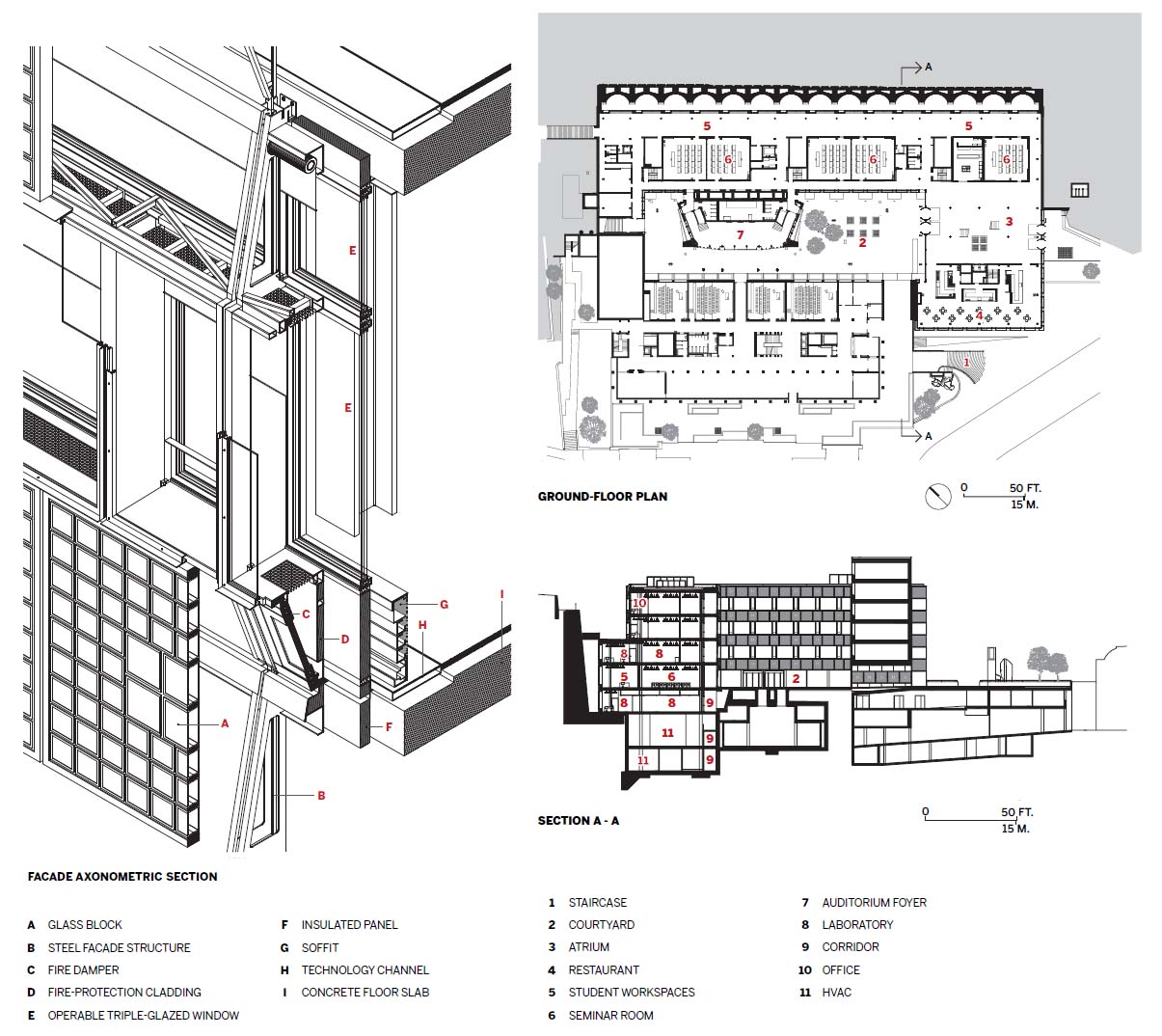
Credits
Architect:
Boltshauser Architekten — Roger Boltshauser, principal; Armin Baumann (project manager); Fabio Tammaro, Stephan Schülecke, Angela Tsang, Simon Spring, Adrian Zimmermann, Erica Pasetti, Sascha Laue, Emanuel Stieger, design team
Engineers:
IBG Engineering (electrical); Waldhauser + Hermann (HVAC); Basler + Hofmann (civil); Balzer (sanitary); SSE (building automation)
Consultants:
Feroplan Engineering (facade); Mettler (landscape); Tonelli (laboratory); Reflexion (lighting); Gruner (fire protection); Durable (sustainability); Urs B. Roth (geometry); Muehlebach Parter (acoustics); Hydraulik (drainage)
General Contractor:
Steiner
Client:
ETH Zurich, Real Estate Management
Owner:
Swiss Confederation
Size:
243,000 square feet
Cost:
$220 million (total)
Completion Date:
March 2023
Sources
Building Envelope:
AEPLI Metallbau, Semadeni Gasbeton, Ruch Metallbau, Gilgen
Interior Finishes:
Artigo, Forbo (flooring); Lindner (modular walls); Inventron, se Lightmanagement (lighting)



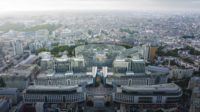
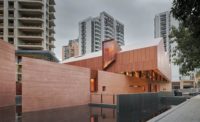
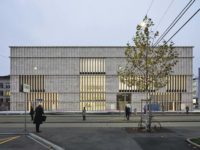
Post a comment to this article
Report Abusive Comment